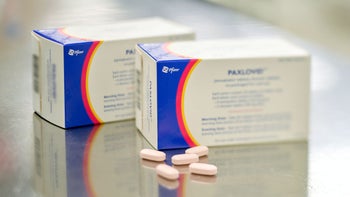
7 Common Paxlovid Interactions You Should Know About (Plus Other Medications to Avoid)
Key takeaways:
Paxlovid (nirmatrelvir / ritonavir) is an oral antiviral medication that’s FDA approved to treat certain people who have mild to moderate COVID-19.
Paxlovid interacts with many medications. Common examples are medications that treat high cholesterol, high blood pressure, and migraines. Other examples include antipsychotics and erectile dysfunction medications.
A healthcare professional should screen for drug interactions before giving you Paxlovid. This is one of Paxlovid’s recommended prescribing steps.
Access savings on related medications
Table of contents

If you have mild-to-moderate COVID-19, you may be eligible to receive a prescription for Paxlovid (nirmatrelvir / ritonavir). It’s an oral antiviral medication that helps lessen the risk of hospitalization or death from COVID, and it’s become more widely available in the U.S. over time.
While availability has improved, safety precautions have remained a priority. A healthcare professional should do a couple of routine checks to make sure Paxlovid is safe for you to take.
Among these, they’ll likely ask you about medications and supplements you take at home. Screening for interactions is one of Paxlovid’s recommended prescribing steps and can help you avoid unwanted side effects.
SHINGRIX (Zoster Vaccine Recombinant, Adjuvanted) is now $0 for almost everyone*
Get SHINGRIX at the pharmacy or in-network doctor’s office today. 98% of privately insured people pay $0 and all Medicare Part D beneficiaries pay $0 at the pharmacy.
Prescribing Information
*Coverage and cost may vary and are subject to change without notice. Reimbursement decisions are made by individual insurance plans.


SHINGRIX is an FDA-approved vaccine for the prevention of shingles (herpes zoster) in adults 50 years and older. SHINGRIX is not used to prevent chickenpox.
• You should not receive SHINGRIX if you are allergic to any of its ingredients or had an allergic reaction to a previous dose of SHINGRIX
• An increased risk of Guillain-Barré syndrome (severe muscle weakness) was observed after vaccination with SHINGRIX
• Fainting can happen after getting injectable vaccines, including SHINGRIX. Precautions should be taken to avoid falling and injury due to fainting
• The most common side effects are pain, redness, and swelling at the injection site, muscle pain, tiredness, headache, shivering, fever, and upset stomach
• SHINGRIX was not studied in pregnant or nursing women. Tell your healthcare provider if you are pregnant, plan to become pregnant, or are breastfeeding
• Vaccination with SHINGRIX may not protect all individuals
• Ask your healthcare provider about the risks and benefits of SHINGRIX. Only a healthcare provider can decide if SHINGRIX is right for you
You are encouraged to report vaccine adverse events to the US Department of Health and Human Services. Visit www.vaers.hhs.gov to file a report, or call 1-800-822-7967.
For US audiences.
Trademarks are property of their respective owners.
©️2024 GSK or licensor.
PMUS-SGXWCNT240015 May 2024
Produced in the USA.
GoodRx Health information and resources are reviewed by our editorial staff with medical and healthcare policy and pricing experience. See our editorial policy for more detail. We also provide access to services offered by GoodRx and our partners when we think these services might be useful to our visitors. We may receive compensation when a user decides to leverage these services, but making them available does not influence the medical content our editorial staff provides.
7 common Paxlovid drug interactions to know about
Paxlovid is made up of two antiviral medications, nirmatrelvir and ritonavir. They’re both necessary parts of treatment. But ritonavir appears to be responsible for the bulk of Paxlovid’s interactions.
Paxlovid gets in the way of certain enzymes (proteins) that are responsible for breaking down medications. This makes the medications stay in your body for longer, which can worsen side effects. Similarly, some medications may make Paxlovid less effective.
Before you head to the pharmacy to get Paxlovid, make sure to bring along an updated list of medications you take. This should include prescription and over-the-counter medications, supplements, and vitamins. This will help your care team prevent and manage any potential interactions.
This isn’t an exhaustive list, but here are some common Paxlovid interactions to be aware of.
1. Statins
Statins are common medications that treat high cholesterol. Atorvastatin (Lipitor), a type of statin, has even been described as the most commonly prescribed medication in the U.S.
While statins are popular at pharmacies, they’re not so agreeable when it comes to interacting with other medications. Paxlovid is no exception to this. Paxlovid can block an enzyme responsible for breaking down statins, causing them to linger in your body. This can worsen the risk of statin side effects, such as muscle pain. In rare cases, rhabdomyolysis (intense muscle breakdown) is also possible.
If you take atorvastatin or rosuvastatin (Crestor), you should avoid taking them while you’re taking Paxlovid. You can start them up again shortly after you finish Paxlovid, though.
If you take simvastatin (Zocor, FloLipid) or lovastatin (Altoprev), there’s a stricter recommendation. You should stop taking them 12 hours before your first dose of Paxlovid. After this, you should keep avoiding them until 5 days have passed since your last dose of Paxlovid.
2. Heart and blood pressure medications
Dozens of heart and blood pressure medications are available in the U.S. Some of the most widely used ones are angiotensin-converting enzyme (ACE) inhibitors, angiotensin II receptor blockers (ARBs), and beta blockers. Thankfully, these don’t interact with Paxlovid. But many other ones do.
What it feels like: Three people share their experiences with Paxlovid, which is beneficial for many people at high risk for severe COVID-19.
The right dose: Paxlovid has a standard recommended dosage. But drug interactions and kidney function can affect how much you should take.
Other COVID treatments: In addition to Paxlovid, read about what other options are available for treating and preventing COVID.
Heart medications
Digoxin (Lanoxin) is a medication that treats heart failure and an abnormal heart rate. You don’t need to avoid combining digoxin and Paxlovid, but know that digoxin levels can go up if you take them together. This in turn increases the risk of digoxin side effects.
Due to a high risk of serious heart changes or other side effects, it’s recommended to avoid Paxlovid with these medications:
Amiodarone (Pacerone)
Dofetilide (Tikosyn)
Dronedarone (Multaq)
Eplerenone (Inspra)
Flecainide
Ivabradine (Corlanor)
Propafenone
Quinidine
Ranolazine (Ranexa)
Blood thinners
If you take a blood thinner or antiplatelet medication for blood clots, there are a few more interactions to keep in mind.
If you take these medications, a healthcare professional may be hesitant to prescribe Paxlovid:
Warfarin (Coumadin, Jantoven)
Rivaroxaban (Xarelto)
Apixaban (Eliquis)
Dabigatran (Pradaxa)
Clopidogrel (Plavix)
Ticagrelor (Brilinta)
Vorapaxar (Zontivity)
Blood pressure medications
Certain blood pressure medications should also be avoided, such as aliskiren (Tekturna).
Other ones can be taken with Paxlovid, but you may be told to use a lower dose. This mostly applies to calcium channel blockers:
Amlodipine (Norvasc)
Diltiazem (Cardizem)
Felodipine
Nicardipine
Nifedipine (Procardia)
Verapamil
3. Certain mental health medications
A few medications for anxiety and depression are known to interact with Paxlovid.
Bupropion (Wellbutrin XL, Wellbutrin SR), bupropion / dextromethorphan (Auvelity), and trazodone are three antidepressants to keep in mind. Paxlovid can make bupropion levels go down, potentially making it less effective. But, in reality, this interaction may not be too worrisome because you'll only take Paxlovid for a few days. It has the opposite effect on trazodone. It can elevate trazodone levels, worsening side effects like dizziness and low blood pressure.
Antipsychotics also fall into this category. Paxlovid can raise the levels of quetiapine (Seroquel) and clozapine (Clozaril) in your body, making side effects more likely to happen. A healthcare professional may want you to take a lower quetiapine or clozapine dose while you’re taking Paxlovid.
Paxlovid can also cause serious reactions with lurasidone (Latuda), and pimozide. You should avoid combining Paxlovid with these medications.
4. Anti-seizure medications
Anti-seizure medications, also called antiepileptic medications, have a different relationship with Paxlovid. Many of them make Paxlovid less effective. This can lead to an undertreated infection and possible medication resistance.
Avoid combining Paxlovid with these medications:
Carbamazepine (Tegretol)
Phenobarbital
Phenytoin (Dilantin, Phenytek)
Primidone (Mysoline)
5. Certain migraine medications
Over the years, many medications and medical devices have been approved and cleared to treat or prevent migraines. They work in unique ways to tackle migraine symptoms, but some of them can interact dangerously with Paxlovid.
One example is eletriptan (Relpax). When taken with Paxlovid, it can cause severe heart or brain-related side effects. Because of this, you should separate Paxlovid and eletriptan doses by at least 3 days (72 hours). Other triptans appear safe to take with Paxlovid.
Ubrogepant (Ubrelvy), rimegepant (Nurtec ODT), and ergot derivatives, including dihydroergotamine, ergotamine, and methylergonovine, are also important to be aware of. You should avoid taking Paxlovid with these migraine medications due to side effects.
6. Hormonal birth control
The world of birth control (contraception) is diverse. Birth control pills, intrauterine devices (IUDs), arm implants, and other options are available for you to choose from.
If you take an oral birth control pill, you may want to check the label and see if it contains ethinyl estradiol. It’s a type of estrogen that’s found in most generic and name-brand birth control pills, including Sprintec, Apri, Junel, and others. It’s also found in vaginal rings and birth control patches.
You can take Paxlovid if you’re taking ethinyl estradiol. But it’s a good idea to use a backup method of contraception, like condoms, while you’re taking it. You may also want to use backup contraception until you get your first period after your last Paxlovid dose. In theory, Paxlovid can diminish ethinyl estradiol’s effectiveness, raising the risk for unintended pregnancies. But since Paxlovid is used for just 5 days at a time, this effect may not be significant.
7. Erectile dysfunction medications
PDE-5 inhibitors are popular medications for erectile dysfunction. They’re used as needed to prior to sexual intercourse. Unfortunately, you may want to keep these medications in the medicine cabinet if you come home with a prescription for Paxlovid.
Avanafil (Stendra) is one of these medications. Paxlovid can raise the amount of avanafil in your body, but we don’t know by how much. Out of caution, avoid this combination.
Sildenafil (Viagra), tadalafil (Cialis), and vardenafil (Levitra) are also PDE-5 inhibitors. They’re more common than avanafil. Combining them with Paxlovid may be OK, but you should ask your prescriber about lowering your dose. Paxlovid can raise the levels of these medications too.
Other Paxlovid drug interactions you should avoid
Due to how often they’re prescribed, the medications above are some of the most common interactions you may come across. But you should also avoid taking Paxlovid — or consider a medication dose adjustment — with these medications:
Alfuzosin (Uroxatral)
Bosentan (Tracleer)
Colchicine (Colcrys)
Cyclosporine (Sandimmune)
Erythromycin (Ery-Tab)
Everolimus (Afinitor)
Finerenone (Kerendia)
Flibanserin (Addyi)
Glecaprevir / pibrentasvir (Mavyret)
Lomitapide (Juxtapid)
Lumacaftor / ivacaftor (Orkambi)
Midazolam
Naloxegol (Movantik)
Opioids like fentanyl
Rifampin
Riociguat (Adempas)
Salmeterol-containing inhalers, such as Wixela Inhub
Silodosin (Rapaflo)
Sirolimus (Rapamune)
St. John’s wort
Suvorexant (Belsomra)
Tacrolimus (Prograf)
Tamsulosin (Flomax)
Tofacitinib (Xeljanz)
Tolvaptan (Samsca)
Triazolam (Halcion)
Upadacitinib (Rinvoq)
Voclosporin (Lupkynis)
Voriconazole (Vfend)
Zolpidem (Ambien)
Many cancer medications
Can you take OTC cold and flu medicines like NyQuil with Paxlovid?
Yes. In general, it’s OK to take over-the-counter (OTC) cold and flu medicines with Paxlovid. OTC cold and flu medicines usually contain one or more of these ingredients:
Dextromethorphan, a cough suppressant
Guaifenesin, an expectorant
An antihistamine like doxylamine or diphenhydramine
A pain reliever like acetaminophen or ibuprofen
A decongestant like pseudoephedrine or phenylephrine
Of these, a minor interaction may only affect some people taking dextromethorphan. It’s available as a standalone medication (Delsym) and in combination products like NyQuil, Mucinex DM, and Theraflu.
If you take Paxlovid and dextromethorphan at the same time, there’s a chance you may experience slightly more dextromethorphan side effects. You don’t need to avoid the combination, but it’s a good idea to let your prescriber know if you experience any new or worsening side effects.
Test your knowledge about Paxlovid
Frequently asked questions
Most people tolerate Paxlovid well. The most common Paxlovid side effects are taste changes and diarrhea. While more severe risks are rare, they include serious skin reactions, liver damage, and allergic reactions. If you experience these severe side effects, seek emergency medical attention.
Yes, you can take Tylenol (acetaminophen) with Paxlovid. The two aren’t known to interact.
In theory, you shouldn’t have to. This is in part due to Paxlovid’s recommended prescribing steps, mentioned above. But if you’re experiencing side effects that you think are related to an interaction, you should contact your prescriber right away. They can help guide you through the situation at hand. And if your symptoms are severe, don’t be afraid to seek medical attention.
The bottom line
Paxlovid (nirmatrelvir / ritonavir) is an antiviral medication that’s FDA approved to treat certain people with COVID-19. But, Paxlovid can worsen the side effects of statins, heart medications, and erectile dysfunction medications. It can also make some medications less effective. A healthcare professional should screen for drug interactions before prescribing you Paxlovid.
Why trust our experts?


References
American Heart Association. (2023). Types of heart medications.
ClinCalc DrugStats Database. (2022). The top 200 of 2022.
Pfizer Laboratories Div Pfizer Inc. (2024). Paxlovid- nirmatrelvir and ritonavir [package insert].
U.S. Food and Drug Administration. (2024). Paxlovid patient eligibility screening checklist tool for prescribers.
Was this page helpful?
Related Articles
Browse medications
View AllResearch prescriptions and over-the-counter medications from A to Z, compare drug prices, and start saving.






















